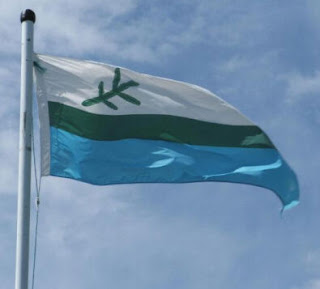Labrador forms part of the Province of Newfoundland and Labrador. Newfoundland and Labrador consists of 2 parts. Newfoundland, a triangular shaped island in Canada's far east, and Labrador forms the triangular shaped territory next to Newfoundland on the mainland.
Originally, Labrador was held by the French, but after the Treaty of Paris in 1763, the territories of "New France" where ceded to British control. Once Britain had finally taken full control, and quelled any troubles from the Francophone population who objected to British rule, the territories of what where now Lower Canada where divided up and became parts of the provinces of Quebec, and Newfoundland.
The Canadian Confederation was originally formed in 1867, with Quebec, Ontario, Nova Scotia, and Prince Edward Island uniting to form the first real "Canada." The rest of the territories joined this nascent Canada over the following 40 years, with Alberta and Saskatchewan joining in 1905.
Newfoundland held out.
The border between Labrador and Quebec (part of Canada) was not settled until 1927. Canada insisted that the border to Labrador essentially existed as a 1 mile strip along the coast. Needless to say, Newfoundland objected. Since both where part of the British Empire, the final decision was made by the Privy council in London, which fixed the border as it is today.
As part of Newfoundlands negotiations with Canada on entry into the Confederation, Newfoundland insisted that recognition of the border be enshrined in the new Canadian constitution, which it was. However, as late as 2001, the Quebec government insisted that it has never recognised the Privy council ruling. This leaves Quebec still in dispute. Though they have not done anything about it!
Recently, there has been a rise in Labrador to cede from Newfoundland itself, and form its own Province. Whether this will happen, we will see. But it is being driven in large part by the First Nations who live in Labrador, who are all applying for homelands. The Newfoundland government has said there will be no movement until the Federal Government makes its decisions.
As such, Labrador's flag is unofficial. But it is widely used.
The top white bar represents the snows of Labrador, with the blue representing the seas, lakes, and waterways which abound across the territory.
The central green bar represents the Spruce tree forests which spread all over Labrador.
In the top hoist corner, there is a spruce tree branch placed over the white stripe. Three of the branches represent the Innu, the Innuit, and the white explorer. The fourth represents the fact that all people are ultimately the same.
The four branches are arranged into growths. The lower 2 are shorter, representing a hard and arduous past, whilst the longer two represent the hopes for a more prosperous future.
The coat of arms use many elements found in the flag of Labrador.
The colours on the shield represent the snows/mountains, the trees, and the waters of the territory. The 4 spruce trees represent the four points of the compass. The star represents the Pole star, a symbol of the territory's location as very much a northern territory.
The supporters are Caribou, animals of historic significance in the lives of the natives, and later, the settlers. Underneath the shield is Caribou moss, and Labrador tea. The crest consists of a Snowy Owl on a wreath of red and gold.
Whether Labradors flag becomes official, we will wait and see!





No comments:
Post a Comment